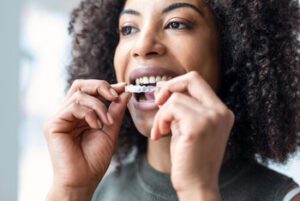In the world of orthodontics, Invisalign has revolutionised how we think about straightening teeth. Offering a less conspicuous alternative to traditional braces, these clear aligners promise a smoother path to achieving that perfect smile.
However, a common question lingers in the minds of potential users: “Does Invisalign hurt?” This blog dives deep into the complexities of Invisalign treatment, shedding light on the pain and discomfort associated with the process, and offers insights on managing it effectively.
The Reality of Invisalign Pain
Embarking on an Invisalign journey is pivotal to achieving the coveted perfect smile. However, this path is often accompanied by various discomforts for which wearers should be prepared.
Understanding the nuances of the discomfort associated with Invisalign can help set realistic expectations and arm patients with strategies to mitigate these issues effectively.
Initial Adjustment and Mild Discomfort

Describing this phase as “Invisalign hurts” captures the essence of the experience for many users, though it’s important to note that this discomfort is typically mild and temporary.
As your mouth becomes accustomed to the aligners’ presence, the discomfort gradually diminishes, transitioning into a more comfortable and manageable experience.
Friction-Induced Gum Pain
A specific aspect of discomfort that deserves attention is the gum pain caused by the friction between the Invisalign trays and the gums. Despite the custom fit of each Invisalign aligner, its edges can sometimes rub against the gums, leading to irritation.
This friction-causing gum pain is most pronounced when a new aligner is first worn and usually subsides as the gums adjust to the new appliance.
To alleviate this, wearers can use dental wax to create a barrier between the aligner and the gums, ensure the aligners are well-fitted, and consult their dentist for adjustments if the discomfort persists.
While the phrase “Invisalign hurts” might capture the initial feelings of some users, it’s crucial to remember that the discomfort experienced is typically mild and temporary.
Mitigating Invisalign Discomfort
While celebrated for its aesthetic and functional benefits in teeth straightening, Invisalign can introduce a range of discomforts, from tooth pain to jaw discomfort.
Understanding how to manage and alleviate these discomforts can greatly enhance the Invisalign experience, making the journey toward a perfect smile as easy as possible. Here, we explore strategies designed to mitigate the discomfort associated with Invisalign, ensuring wearers can navigate their treatment with minimal distress.
Addressing Tooth Pain and Jaw Discomfort
Tooth pain and Invisalign jaw pain are among the most common concerns for new aligner wearers. These discomforts typically arise from the pressure exerted on the teeth and jaw as they gradually move to new positions. While some degree of discomfort is to be expected, there are several measures you can take to manage and reduce these sensations:
Gradual Adjustment: Allowing your mouth to adjust to the new aligners gradually can help lessen the intensity of tooth pain and jaw discomfort. This means adhering strictly to the wear schedule advised by your dentist, ensuring your mouth becomes accustomed to the pressure in a steady, controlled manner.
Pain Management Techniques: Over-the-counter pain relief medications can effectively manage acute phases of discomfort, especially after introducing a new set of aligners. Follow the recommended dosage and consider timing the medication to coincide with new aligner adjustments.
Cold Therapy: External cold compress to the jaw can help reduce inflammation and numb the area, providing temporary relief from pain and discomfort. Ensure the cold compress is applied intermittently to avoid any adverse effects from prolonged cold exposure.
Easing the Invisalign Experience
Minimising the minor discomfort associated with Invisalign involves adopting practices that address the physical sensations of pain and the overall experience of wearing the aligners.
Dietary Adjustments: Switching to a diet of softer foods can significantly reduce the strain on your teeth and jaw, especially during periods of heightened sensitivity. Foods that require minimal chewing effort can prevent exacerbating tooth pain and discomfort.
Oral Hygiene Practices: Maintaining impeccable oral hygiene can prevent additional sources of discomfort, such as irritation from trapped food particles. Regular teeth and aligner cleaning can make the treatment experience as comfortable as possible.
Aligner Maintenance: Ensuring your aligners are properly maintained and free from rough edges that can irritate the gums and inner cheeks is crucial. In cases where the aligners irritate, orthodontic wax can be applied to the problematic areas, offering a protective barrier against friction.
Proactive Measures to Avoid Invisalign Pain
Taking proactive steps to avoid or minimise Invisalign pain can significantly affect the treatment experience. Here are a few additional tips:
Wearing New Aligners at Night: Inserting new aligners before bedtime can allow you to sleep through the initial hours of adjustment, reducing the immediate sensation of discomfort.
Staying Hydrated: Keeping well-hydrated can alleviate some discomfort associated with Invisalign, as a moist oral environment is less prone to irritation.
Consultation and Communication: Regular check-ins with your dentist can ensure that any significant discomfort is addressed promptly, potentially adjusting the treatment plan to suit your tolerance levels better.
Comparing Invisalign to Traditional Braces

This is primarily due to the lack of metal brackets and wires that can cause additional irritation in the mouth. However, the experience of pain is highly subjective and can vary widely among individuals.
Frequency and Duration of Pain
Invisalign pain is typically most pronounced at the beginning of treatment and when switching to a new aligner in the series.
This discomfort usually subsides within a few days as the teeth adjust to new positions. Wearers must remember that pain signifies progress, a sign that the aligners are working as intended.
Strategies for New Aligners
Transitioning to a new set of Invisalign aligners often brings a wave of anticipation and, for some, apprehension due to the discomfort accompanying the initial phase of adjustment. Knowing how to manage and mitigate this discomfort effectively is key to a smoother, more pleasant Invisalign experience. Below are strategies specifically tailored to help you deal with introducing new aligners, utilising the suggested keywords to ensure a comprehensive approach.
Embrace Soft Foods to Minimise Discomfort
One of the simplest yet most effective strategies to avoid Invisalign pain, especially following the switch to new aligners, is to opt for a diet of soft foods.
Hard, crunchy, or sticky foods can exacerbate the pressure on your teeth, leading to unnecessary discomfort. Soft foods require less chewing effort, reducing the strain and helping you experience mild pain rather than severe discomfort.
Utilise Dental Wax for Protection
The edges of new Invisalign aligners can sometimes irritate the gums and the inside of your mouth.
Applying dental wax to any area of the aligner causing friction can provide a smooth barrier, preventing cuts and sores and significantly reducing the chance of experiencing invisalign pain.
Implement Cold Compresses for Relief
Facial swelling and mild pain are not uncommon with the introduction of new aligners, as the teeth and gums adjust to the new pressure.
Applying a cold compress to the outside of your face can help reduce swelling and numb the discomfort, offering immediate relief. Remember to wrap the ice pack in a cloth to protect your skin and limit each application to 20-minute intervals to avoid frostbite.
Take Pain Killers as Necessary
Over-the-counter painkillers can be an effective remedy when the discomfort escalates beyond tolerable.
Medications such as ibuprofen or acetaminophen can help manage severe pain and inflammation. However, using these sparingly and by the recommended dosage is important to avoid any potential side effects.
Experience Mild Pain with Proper Hygiene
Maintaining excellent oral hygiene can significantly reduce the risk of unnecessary discomfort associated with new aligners.
Ensuring that your teeth and the aligners are clean can prevent irritation caused by trapped food particles or bacteria, allowing you to experience only mild pain, if any, during the adjustment period.
Deal with Invisalign Discomfort Proactively
Proactive measures can significantly reduce the duration and intensity of discomfort associated with new Invisalign aligners.
Inserting new aligners at night can help you sleep through the initial hours of adjustment. Additionally, using a cold compress and taking painkillers before the discomfort peaks can help manage symptoms more effectively, ensuring you experience mild pain rather than severe.
When Does Invisalign Stop Hurting?
Most Invisalign wearers notice a significant decrease in discomfort after the first few weeks of treatment. As the mouth adjusts to the feeling of the aligners and the teeth begin to move, the pain sensation diminishes, leading to a more comfortable experience overall.
Conclusion

Don’t let discomfort deter you from achieving your perfect smile. Contact Balmoral Dental Centre today at (07) 3113 9789 to discuss how we can help you manage your Invisalign discomfort and keep you on track towards your smile goals. Your comfort and satisfaction are our top priorities, and we’re here to assist you every step of the way.
References:
https://www.forbes.com/health/dental/does-invisalign-work/
https://www.healthline.com/health/dental-and-oral-health/does-invisalign-hurt#:~:text=Any%20pain%20or%20discomfort%20you,dental%20aligners%20within%20a%20week.

